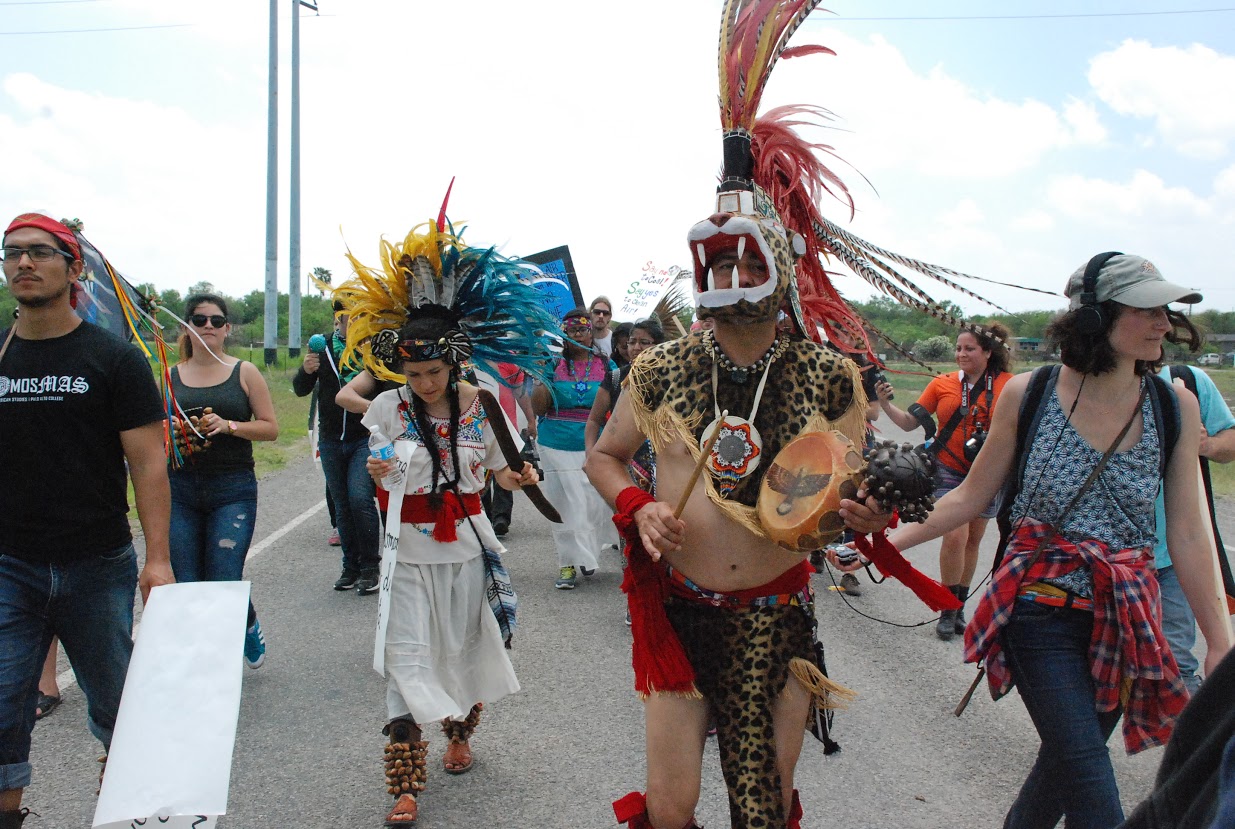
by Deep Green Resistance News Service | Apr 24, 2016 | Mining & Drilling, Protests & Symbolic Acts
Via Censored News
EAGLE PASS, Tex. — Native American Groups gathered today for a historic rally and march to protest the open-pit coal strip mine in Eagle Pass, Tex. The protesters called on the U.S. Army Corps of Engineers to rescind the mine’s permit, halt expansion and protect the land from further destruction. The project, owned by Dos Republicas Coal Partnership, mines lignite coal, which is transported by train from Maverick County across the border to be burned in a Mexican coal-fired power plant. The mine began operating several months ago, despite local opposition, and is harming the ancestral homelands of many Native groups and damaging sacred lands and more than 100 archaeological sites.
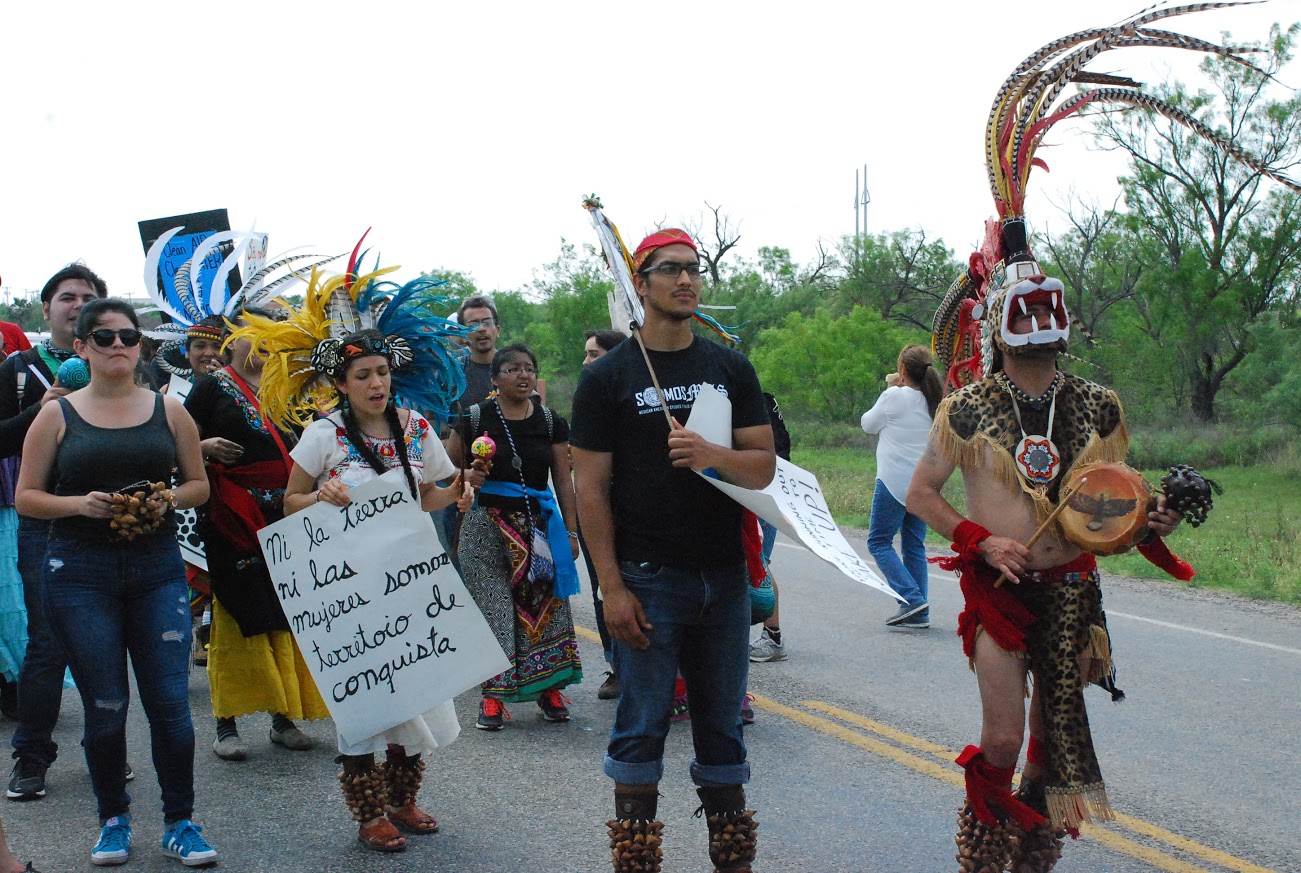
“This mine has already caused irreparable damage, destroying multiple burial sites and erasing our cultural heritage in the process,” said Maria Torres, Tribal Chairwoman of the Pacuache Clan of Texas. “This land is our patrimonial heritage, and it holds the story of our ancient aboriginal people—how we lived and how we died. When we lose access to our land and to the ancient wildlife of the area, from the jaguarundi and ocelot to crucial plant life, we lose part of our heritage and our connection with Mother Earth.”
Many Native groups say they were not properly consulted by Federal agencies as required prior to granting the permits necessary for the coal mine to open. More than eight thousand Eagle Pass residents and allies signed a petition in opposition to the Dos Republicas mine before its opening.

“This project is the worst example of environmental injustice I’ve seen,” said Dr. Jonathan Hook, former Director of Environmental Justice and Tribal Affairs for the EPA, Cherokee Nation citizen and Maverick County resident. “Everything about it is wrong. Given the incomplete processes and potential damage to one of the most vulnerable communities in the country, the Dos Republicas mine should have been stopped before it even started.”
Representatives from the Lipan Apache Band of Texas, Pacuache Band Coahuiltecan Nation, Carrizo-Comecrudo Tribe of Texas, and American Indian Movement of Central Texas were present at the Saturday event, which included Native regalia, drumming, and other cultural expressions along with large banners, signs, and puppets.
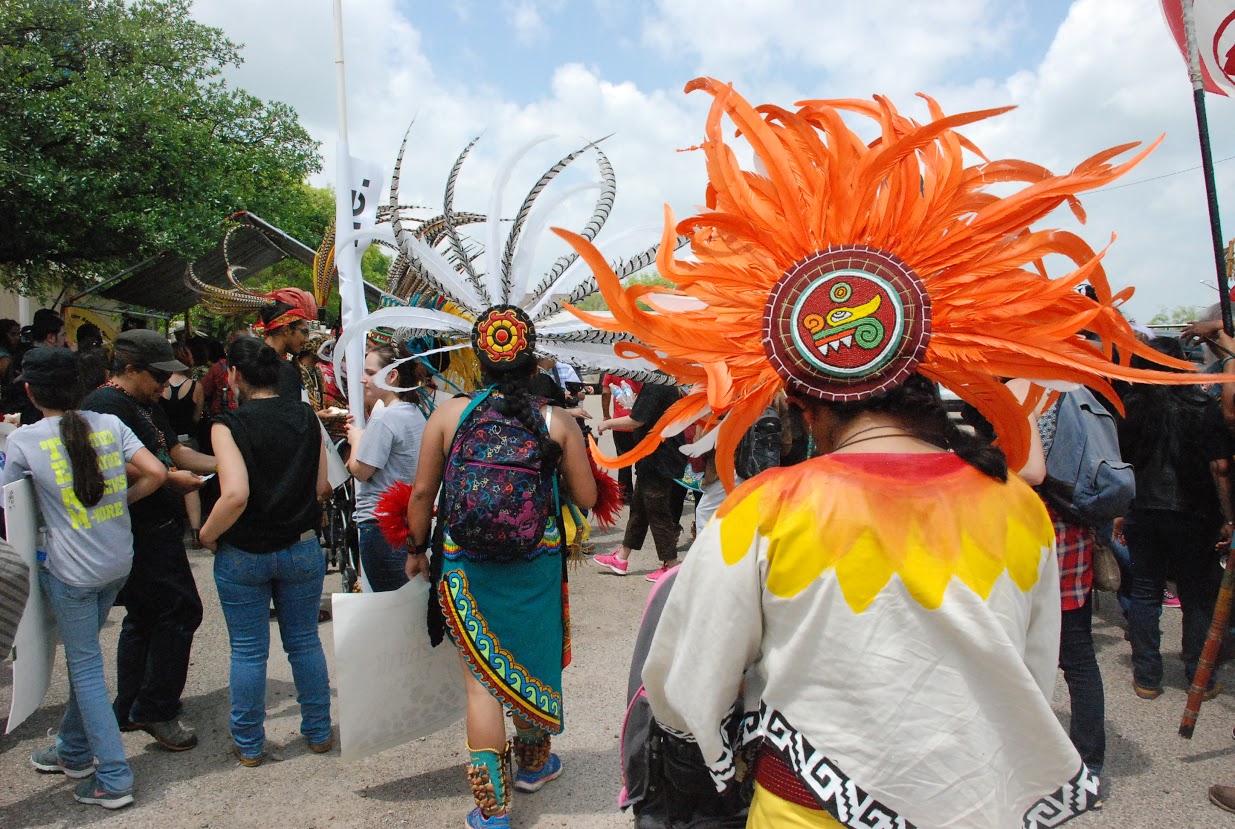
“Native leaders, tribal members and allies from across the country are uniting here today, and they join thousands from the area who are standing up against this disastrous project,” said Dr. Tane Ward, and Native and decolonial organizer working with the Sierra Club. “It’s unclear why the state of Texas has been so supportive of the controversial mining project. Not only does it harm culturally rich and historic land, the Dos Republicas mine threatens the safety and livelihood of those who live nearby all so the coal can be shipped to Mexico and burned in coal plants. It’s time for this dangerous project to be stopped, once and for all.”
Read more about the Dos Replicas Mine at the Sierra Club Lone Star Chapter’s website.
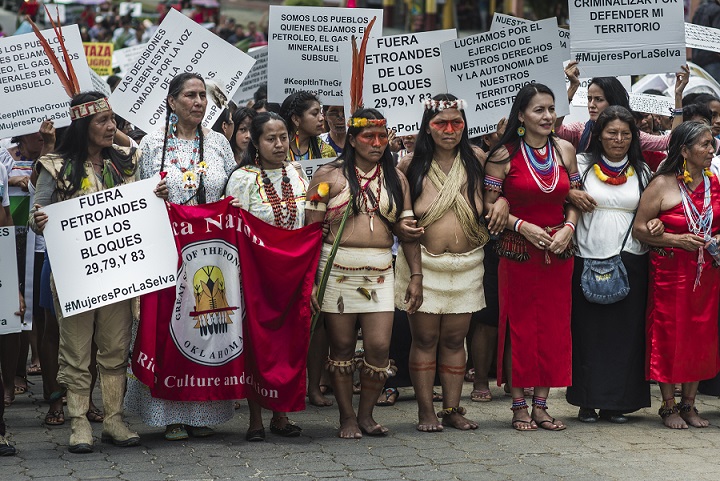
by Deep Green Resistance News Service | Mar 9, 2016 | Indigenous Autonomy, Protests & Symbolic Acts
By WECAN International
SAN FRANCISCO, Calif., March 9, 2016 – In recognition of International Women’s Day, Indigenous Amazonian women leaders of seven nationalities including: Andoa, Achuar, Kichwa, Shuar, Shiwiar, Sapara and Waorani nationalities and their international allies took action in Puyo, Ecuador, in a forum and march in defense of the Amazon, Mother Earth and for climate justice. Specifically, they came together to denounce a newly signed oil contract between the Ecuadorian government and Chinese oil corporation Andes Petroleum.
By plane, foot, canoe, and bus, some five hundred women mobilized from deep in their rainforest territories and nearby provinces marching through the streets of the Amazon jungle town of Puyo.
Chanting, “Defend the forest, don’t sell it!” and carrying signs reading “No more persecution against women defenders of Mother Earth,” the march culminated in a rally in which each nationality denounced the new oil threat and shared traditional songs and ceremonies. The women spoke of other methods for protecting and defending the Amazon and its vital living systems, making it known that the women of the Amazon are not just victims of environmental and cultural genocide, but rather are vital solution bearers.
In addition to highlighting the grave social and ecologic implications of this new contract and the Ecuadorian government’s plans to tender several more oil blocks in the pristine, roadless southern Amazon, the women and allies brought light to their struggles and the ongoing criminalization faced as they stand to protect and defend their territories and lifeways based upon living in harmony with the natural world. A tribute was held in honor of Berta Caceres, the Honduran indigenous environmental leader who was killed last week for her years of work defending rights and territories from privatization, plantations, and most recently, a mega dam project.
The women of the Amazon were also joined by Casey Camp Horinek, WECAN delegation member and Indigenous leader of the Ponca Nation of Oklahoma, who shared her traditional songs and stories of how her people have been impacted by fracking activity.
“Right now the oil company is trying to enter our territory. That is our homeland, this is where we have our chakras (gardens), where we feed our families. We are warriors, and we are not afraid. We will never negotiate,” explained Rosalia Ruiz, a Sapara leader from the community of Torimbo, which is inside the Block 83 oil concession.
“Although we are from three different provinces, we are one territory and one voice,” Alicia Cahuiya, Waorani leader declared.
As the march unfolded, the Ecuadorian government and Andes Petroleum held a meeting in the nearby town of Shell to organize an illegal entry into Sapara territory, knowing that key leaders would not be present. Outraged, a delegation of Sapara delivered a letter to the meeting, underscoring their peoples’ opposition to the oil project and governments tactics to divide the community. They successfully thwarted the government and company plans, and returned to the streets, victorious.
International allies including the Women’s Earth and Climate Action Network, Amazon Watch and Pachamama Alliance shared messages of solidarity and calls for immediate action to keep fossil fuels in the ground in the Amazon.
“On this International Women’s Day we are reaching across borders and standing together as global women for climate justice to denounce oil extraction in the Amazon and call for attention to the struggles and solutions of local women land defenders,” explained Osprey Orielle Lake, Executive Director of the Women’s Earth and Climate Action Network, “We all depend on the flourishing of these precious rainforests, the lungs of the planet. Now is the time to keep the oil in the ground and stand with the women who have been putting their bodies on the line for years to protect the forest, their cultures, and the health and well being of all future generations.”
“Today was a historic day for indigenous Amazonian women! It was the first time that hundreds of women and their allies marched for the Amazon, Mother Earth and Climate Justice. And the power of women was so strong that plans for oil companies entering Sápara territory today were halted. This is is a signal that the collective call to defend rights and territories by keeping fossil fuels in the ground is working,” says Leila Salazar-López, Executive Director of Amazon Watch.
Belen Paez from Pachamama Alliance declared: “It’s a unique and historical moment to have the experience of solidarity and connection between indigenous women and activists from all over the world standing up for the rights of the Amazon rainforest and its people, we have all been waiting for this moment for so long, and that moment is now.”
The March 8 forum, action and press conference will be followed by a March 9 event and report back, ‘Women of Ecuadorian Amazon and International Allies Stand For Protection of the Amazon Rainforest’ to be held on March 9 at 17:00 at the Biblioteca FLASCO, Universidad FLACSO, Quito.
A solidarity action was also held at the Chinese consulate in San Francisco, CA, to denounce the new oil contracts on Sapara and Kichwa territory and support women’s rights in Ecuador and around the world.
-# # #-
About The Women’s Earth & Climate Action Network (WECAN International)
www.wecaninternational.org
@WECAN_INTL
The Women’s Earth and Climate Action Network (WECAN International) is a solutions-based, multi-faceted effort established to engage women worldwide as powerful stakeholders in climate change, climate justice, and sustainability solutions. Recent work includes the International Women’s Earth and Climate Summit, Women’s Climate Declaration, and WECAN Women’s Climate Action Agenda. International climate advocacy is complemented with on-the-ground programs such as the Women’s for Forests and Fossil Fuel/Mining/Mega Dam Resistance, US Women’s Climate Justice Initiative, and Regional Climate Solutions Trainings in the Middle East North Africa region, Latin America, and Democratic Republic of Congo. WECAN International was founded in 2013 as a project of the 501(c)3 Women’s Earth and Climate Caucus (WECC) organization and its partner eraGlobal Alliance.
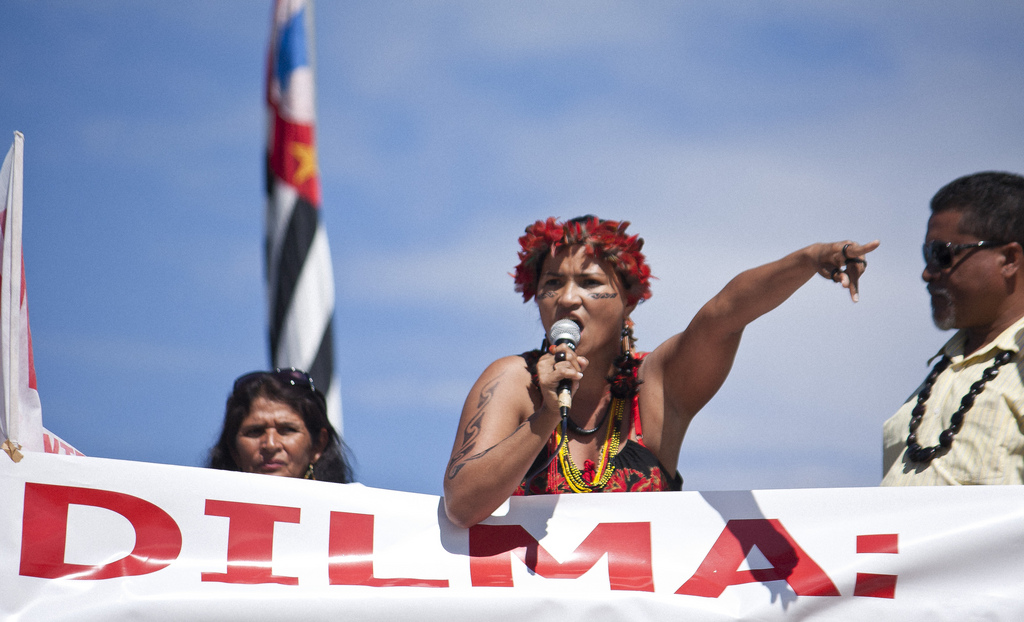
by DGR News Service | Mar 8, 2016 | Protests & Symbolic Acts, Strategy & Analysis
Featured image: Sheyla Juruna/flickr
By Derrick Jensen / Deep Green Resistance
Let me say upfront: I like fun, and I like sex. But I’m sick to death of hearing that we need to make environmentalism fun and sexy. The notion is wrongheaded, disrespectful to the human and nonhuman victims of this culture, an enormous distraction that wastes time and energy we don’t have and undermines whatever slight chance we do have of developing the effective resistance required to stop this culture from killing the planet. The fact that so many people routinely call for environmentalism to be more fun and more sexy reveals not only the weakness of our movement but also the utter lack of seriousness with which even many activists approach the problems we face. When it comes to stopping the murder of the planet, too many environmentalists act more like they’re planning a party than building a movement.
For instance, there’s a video on YouTube of supermodels stripping, allegedly to warn us about global warming. How better to warn us than for a supermodel to shimmy out of her clothes to the accompaniment of a driving rock beat? The tagline beneath the video says, “No matter what your politics are, I think we can all get behind the notion of supermodels stripping.”
Well, not me. The video reinforces the values of a deeply misogynistic culture, where women’s bodies are routinely displayed for consumption by men, where pornography is a 90 billion dollar industry and the single largest commercial use of the internet. And in a movement that already loses women in droves because they’re objectified, harassed, raped, and silenced by men they’d considered comrades, do we really want to use recruiting tools that further this objectification?
Contrast the supermodel strippers with the Message from Sheyla Juruna, also on YouTube. A spokesperson for the indigenous Juruna peoples of the Xingu River in Brazil, Sheyla Juruna stares straight into the camera and says: “The Belo Monte dam is a project of death and destruction. It will decimate our populations and all of our biodiversity . . . We’ve already attempted various forms of dialogue with the government, doing everything we can to block this project, but we have not been heard. I think that it is now time for us to go to war against Belo Monte. No more dialogue. Now is the time to make more resolute and serious acts of resistance against this project.”
I guarantee that Sheyla Juruna did not become an activist for the fun and sex.
What’s more, the “fun and sexy” approach to environmentalism attempts to mobilize techniques that were developed for selling products toward building a movement. Showing a woman’s orgasmic face as she picks up a bottle of fabric softener may influence some people to purchase that brand. But becoming an activist is an entirely different process from buying fabric softener. The former requires fortitude, discipline, and dedication, while the latter requires four dollars to purchase the “natural brand that makes your laundry fluffy, cuddly, and static-free.”
In the arena of public relations, the U.S. military understands all too well something that environmentalists completely fail to grasp: How many recruiting ads have you seen selling the military as fun and sexy? None. An adventure, yes. Service to the community, yes. The few, the proud, yes. All of which, by the way, could and should be said about activism. Recruitment based on fun and sex will attract those who are in it for the fun and sex. Which means that either there will be a very high rate of attrition among such recruits or, far worse, the activism itself will become superficial enough to retain them. It ought to be obvious but in case it’s not: You can’t build a serious movement on superficiality.
The problems themselves are neither fun nor sexy, and the work of resolving these problems is anything but superficial. Organizing is hard work, sometimes tedious, often enraging, and, at this point in the ongoing murder of the planet, nearly always heartbreaking. Sheyla Juruna’s message isn’t about fun and games. Her message is about life and death — her own, that of her people, and that of the land without whom her people are no longer themselves.
Unfortunately, the notion that activism (they never dare call it resistance) has to be fun and sexy pervades the entire environmental movement, from the most self-styled radical to the most mainstream reformist. I have in my hands the most recent issue of the Earth First! Journal, which includes a photo from the most recent Earth First! Rendezvous (events that have a well-deserved reputation for drunken debauchery) depicting young men and women making a naked human pyramid. Remind me what this has to do with stopping this culture from killing the planet? Can you imagine Freedom Riders making coed naked human pyramids, painting their faces, or bringing papier-mâché puppets to sit-ins?
Or consider a recent campaign involving college students stripping to their underwear (do you see a theme?) and running around their campuses. A promotional article titled “Expose Coal Company Lies — With Your Underwear” begins, “Who doesn’t love a good cause that you can support by taking off your pants?” The “project” is a partnership between the Sierra Club and a “stylish underwear brand” called PACT. The Sierra Club, we are told, reports: “Over the past few weeks, students from coal-powered campuses have already used the underwear line in conjunction with organized events such as flash mobs, where students spontaneously [sic] strip down to their ‘Beyond Coal’ underwear, and a race to renewables, a cross-campus underwear run to advocate for the use of cleaner fuel sources.” An embedded video of the “underwear flash mob” is so thoroughly embarrassing (and depressing) that I truly hope you don’t look it up. Beneath the video, the text reads, “Hats Pants off to the Sierra Club and PACT!”
Do I really need to explore what’s wrong with (and creepy about) Sierra Club leaders and underwear makers encouraging young people to take off their clothes, much less pretending this is activism? I’m thinking about a recent global warming campaign where “3,000 people in New Delhi formed an enormous elephant threatened by rising seas — a plea to world leaders not to ignore the ‘elephant in the room.’” I’m thinking about face painting, and I’m thinking about puppets. And I’m thinking how spectacle supplants reality.
I’m also thinking about a conversation I had with some First Nations people in Vancouver, British Columbia, who described how, during the anti-Olympics protests, some Indian warriors were standing firm, alongside some of their nonindigenous allies, facing down police over the desecration of their lands. And they looked behind them and saw a physical separation between themselves on the one hand, and a big cohort of mostly white protesters on the other. But the separation was far more than physical, because the people in front were all dead serious, and behind them were any number of people wearing bunny costumes or running around in cardboard models of bobsleds.
When and why and how did partying and spectacle and debauchery become a substitute for serious political organizing and resistance? How did taking off one’s pants and running around become a political act? And where does dignity fit into any of this? There is, of course, a role for absurdity in political discourse. But the role of absurdity in political discourse is to ridicule and humiliate those in power, not ourselves.
The Jews in the Warsaw Ghetto Uprising took up arms in defense of their lives. The Shawnee war chief Tecumseh took up arms in defense of his people and his land. Harriet Tubman risked her own life to free her people. We, on the other hand, have a long way to go to form a serious resistance movement.
Originally published in the January/February 2012 issue of Orion.
First published online here.
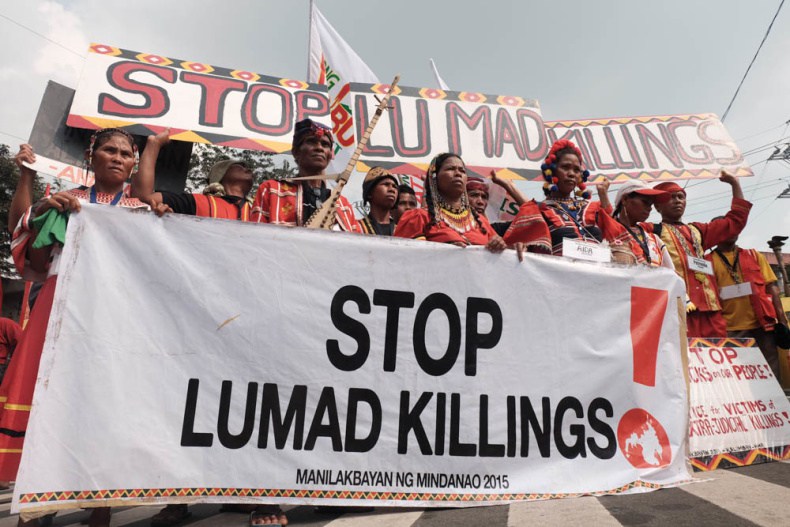
by DGR Colorado Plateau | Dec 21, 2015 | Colonialism & Conquest, Mining & Drilling, Protests & Symbolic Acts
By Hannibal Rhoades / Intercontinental Cry
Last week, a 3,000 person-strong people’s caravan, or Lakbayan, formed on the island of Mindanao to protest the criminalization and murder of Indigenous Peoples and environmental defenders in the Philippines.
Uniting Indigenous Peoples, peasants, workers, faith groups, teachers and youth, the caravan marched for three days and over a hundred kilometers from Davao del Sur to Koronadal City under the banner ‘Resist imperialist plunder! Stop Lumad killings!’
Though the numbers reported vary, the organizers of the caravan say 144 indigenous people, environmental defenders and human rights activists have been the victims of extrajudicial killings during the reign of incumbent President Benigno Aquino.
In a statement released before the Lakbayan, the groups connected these killings and rights abuses to the increasing presence of the extractive industries in Mindanao and the Philippines.
“These human rights abuses glaringly persist in the ancestral domains where the big and foreign mining companies and agri-plantations operate,” they said.
These killings form part of a wider pattern. According to research by UK-based think tank Global Witness, two environmental defenders are killed every week as they work to protect their lands from being appropriated and exploited by mining companies and other industrial interests.
In recent years, the Philippines has become a hot spot for these killings. But, as is the case around the world, very few of those responsible for the murders of environmental defenders ever see a court of law. Around the world between 2002-2013, perpetrators of such killings were brought to justice in less than one percent of cases.
STOP LUMAD KILLINGS
On Sept. 1, 2015 educator Emerito Samarca and two Lumad leaders, Dionel Campos and Aurelio Sinzo, who opposed large scale mining, were brutally murdered in Lianga, Mindanao. According to local reports, the men were killed in the heart of the community by members of the Maghat/Bagani paramilitary group, attached to the 36th Infantry Battalion of the Philippine Army.
Speaking at COP21 in Paris, Clemente Bautista, National Coordinator for Kalikasan PNE, described how the Armed Forces of the Philippines and affiliated paramilitaries are implicated in the terrorization of Indigenous and peasant peoples.
“The government is using militarization to protect corporate mining in the Philippines. They use the state military forces including paramilitaries to secure mining projects, quell the people’s resistance, and sow fear among the people, particularly those in mining-affected communities. Mining corporations, military and paramilitary groups employ violence such as harassment, illegal arrest and assassination, targeting anti-mining leaders,” he said.
The killings of Samarca, Campos and Sinzo are the latest in a spate of murders that has seen 56 Lumad leaders assassinated for protecting their lands and communities.
The “Lianga Massacre,” as it has become known, sparked international outrage and a day of solidarity and action that called on the Philippine Government to Stop Lumad killings. But the more diffuse consequences of the terror these kinds of killings are designed to produce have been underreported outside of the Philippines.
The relentless persecution of the Lumad People is creating a climate of terror in Mindanao that is profoundly impacting the freedom of the Lumads to live their lives freely.
In their statement before the three-day Lakbayan, organizing group Soscskargends Agenda revealed how the rising tide of violence in Mindanao has contributed to the internal displacement of up to 40,000 Lumads. The Lianga Massacre alone forced over 3,000 local Lumads to flee their isolated villages in Surigao del Sur to nearby towns, fearing for their lives.
The constant threat of violence in Mindanao and the panic migrations that result are having a particularly negative impact on Indigenous children. According to Soscskargends Agenda, at present 9 out of 10 Lumad children have no access to formal education and 87 Lumad schools are suffering from “various forms of military violence”.
“The 36th IB Philippine Army-Magahat/Bagani rampage at the ALCADEV School shows that the Aquino government has dropped all pretenses of adhering to the United Nations Convention on the Rights of the Child and other international human rights instruments,” say the International Coalition for Human Rights in the Philippines.
The Lakbayan gave the groups involved an opportunity to elevate these underrepresented issues and create a platform for several urgent demands.
The groups are calling upon the Philippine government, first and foremost, to stop the killing of Lumad people, protect indigenous and peasant schools in Mindanao, and pull the plug on the large scale multinational mining projects that they say are helping fuel poverty and violence in the Philippines.
THE RESOURCE CURSE
Mindanao has become known as the “mining capital” of the Philippines. The island is peppered with 500,000 hectares of mining concessions, an area almost eight times larger than Metro Manila, the National Capital Region of the Philippines. These concessions have overwhelmingly been granted to multinational corporations, many of which are registered in Global North nations such as Canada.
Other islands in the Philippines, estimated to be the sixth richest nation in the world in terms of mineral and metals, have experienced a similar expansion of large scale mining since the Philippine Mining Act of 1995 (Republic Act 7942). The Act liberalized the country’s mining sector, promising economic growth and development through the exploitation of the country’s natural resources with the help of multinational corporations.
However, many Filipino civil society and indigenous groups argue that the liberalization of the mining sector has led to rising poverty, not prosperity, for Filipinos.
In a recent report,* Philippine people’s network Kalikasan PNE write that, based on data from the Philippine Bureau of Internal Revenue, between 1997 to 2013 less than 10% of mining revenues generated in the Philippines stayed in the country’s economy. According to their research, mining contributes only 0.7 percent to Philippine GDP and provides just 0.7% of employment.
The significance of these figures is emphasized when the costs mining corporations inflict on ecosystems and local communities are considered. The presence of multinational mining corporations in the Philippines has unleashed a tidal wave of environmental destruction on local indigenous and rural communities, costing thousands of livelihoods, devastating ecosystems and sustainable local economies.
The Marcopper disaster at a mine the owned by Canadian multinational Placer Dome on the island of Marinduque provides a good example.
On March 24, 1996 a sealed mine tunnel connected to a pit containing 23 million metric tons of mine waste fractured, leaking between 2-3 million tons of the waste into the Boac River. Residents of twenty local villages were forced to leave their homes, some of which were totally inundated by the flash flood of mine waste.
Agricultural fields were also flooded and the rapid destruction of all aquatic life in the Boac, a key source of livelihoods for local fishing communities, led the Philippine government to declare the river dead. Local peoples had already suffered decades of chronic environmental pollution, loss of livelihoods and ill health as the result of mining.
Dozens of other mining disasters have occurred in the period since the Mining Act of 1995 was passed. “Simply put,” write the authors of Kalikasan’s report, “we have experienced two decades of mining plunder.”
RESISTANCE AND MILITARIZATION
The two decades since Mining Act of 1995 was signed into existence have also been characterized by escalating resistance efforts from Indigenous Peoples, peasants and their supporters at the local, national and international levels.
Indigenous Peoples in particular have taken a stand to defend their territories, even taking up arms to protect their lands. In some cases this sustained resistance has been successful in preventing mining projects going ahead.
In June 2015, the Indigenous B’laan people and Philippine environmental groups celebrated mining giant Glencore Xstrata’s decision to pull out of the highly contested Tampakan copper-gold mining project. The company had been attempting to get mining under way since taking ownership of the project in 2001, but met powerful resistance from the B’laan.
The Philippine government’s response to such strong, sustained and well organized resistance has been to increasingly militarize areas where multinationals are operating, as seen in the case of Samarca, Campos and Sinzo.
The organizers of the recent Lakbayan say the current Aquino government’s “vicious internal security doctrine,” Oplan Bayanihan, is being used as a cover to to attack the schools, communities and leaders of those who actively resist mining.
The stated aim of Oplan Bayanihan, a government counter insurgency program, is to squash the New People’s Army (NPA), a communist guerrilla group that has been warring with the Philippine government for over two decades. However, the powers contained in the plan are also used to criminalize anti-mining activists who threaten the interests of multinationals in regions like Mindanao.
These activists are frequently accused, by the government, military and paramilitaries, of being connected with the NPA. Branded as anti-government rebels their intimidation, incarceration and/or murder is effectively excused.
But even this systematic state repression is not stopping people standing up for their rights, says Bautista.
“We say more oppression breeds stronger resistance. Surely the government and corporations will continue to trample the rights of the indigenous people and other sectors. This will make Indigenous Peoples and ordinary people more united and their collective struggle stronger.”
Holding cultural events, forums and symbolic actions along the way, the recent Lakbayan paid testimony to this theory, as people voted with their feet and raised their voices for justice.
*The report,
Kalibutan: Stories and lessons from the Filipino people’s struggle for the environment, is not yet available online. Visit
Kalikasan PNE’s website to make inquiries and find out more.
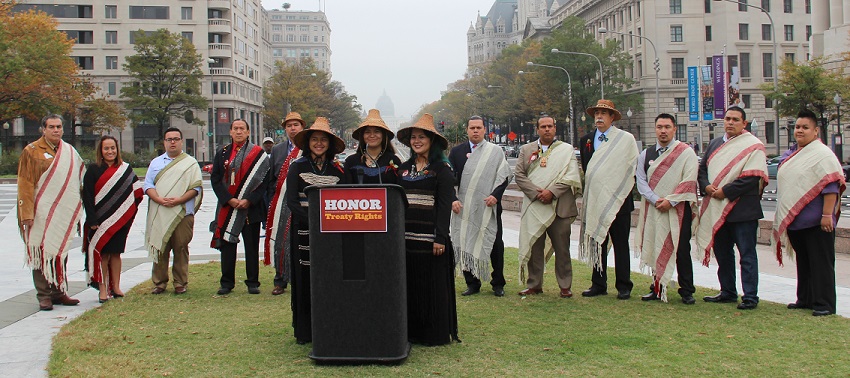
by DGR Colorado Plateau | Nov 19, 2015 | Indigenous Autonomy, Protests & Symbolic Acts
Lummi tribal leaders and members gathered last Thursday in Washington, D.C. to express concerns about treaty violations related to the proposed coal terminal and train railway for Cherry Point, Washington.
In addition to the Lummi Nation, tribal members and leaders from the Tulalip, Swinomish, Quinault, Lower Elwha Klallam, Yakama, Hoopa Valley, Nooksack and Spokane nations were in attendance.

Chairman of the Lummi Nation Tim Ballew II expressed his concerns last Thursday in Washington, D.C. to express concerns about treaty violations related to the proposed coal terminal and train railway for Cherry Point, Washington.
Chairman of the Lummi Nation Tim Ballew II came to the podium and told attendees and news crews that the 1855 U.S. treaty with Pacific Northwest Native American tribes, and associated rights for the fishing, hunting and sacred grounds was in jeopardy.
“We’re taking a united stand against corporate interests that interfere with our treaty-protected rights,” said Tim Ballew II, chairman of the Lummi Indian Business Council. “Tribes across the nation and world are facing challenges from corporations that are set on development at any cost to our communities.”
According to a release, for three years, Northwest treaty tribes, including Lummi Nation, Swinomish Indian Tribal Community, Tulalip Tribes, and Yakama Nation, and the Columbia River Intertribal Fisheries Commission have provided government agencies and elected officials detailed letters identifying the impacts the terminal would have on treaty fishing rights, the environment, natural resources and the health of Washington.

Lummi tribal members and sisters Billy Kennedy Jefferson, 18, Danielle Kennedy Jefferson, 16, and Kathrine Jefferson, 15, all from the Lummi Nation in western Washington state Photo: Vincent Schilling
Additionally, the Affiliated Tribes of Northwest Indians, representing 57 tribes, has taken action to oppose the increased transport of unrefined fossil fuels of coal, Bakken shale oil, and tar sand oil across the Northwest. The proposed Gateway Pacific Terminal would impact thousands of acres of treaty land and fishing along the rivers and mountains. Tribes across the Northwest have concluded that the impacts of significant increases in rail and vessel transportation cannot be mitigated to any level that would protect tribal treaty rights.
The proposed Gateway Pacific Terminal (a subsidy of SSA Marine) would serve as a gateway to markets in domestics companies and Asia. The terminal would handle 60 million tons of commodities, mostly coal – but the project’s location includes Lummi ancestral burial sites and ancestral fishing grounds.
“The location of the pier will take away fishing grounds and the increase in vessel traffic would impede access of our fishermen to fishing grounds throughout our usual and accustomed areas.”
“We soundly reject developments that desecrate our sacred places and call on Congress to uphold our treaty-protected rights,” said Ballew.
“I credit the current administration for every year building on our efforts to help us rebuild our nations and I encourage them to continue that,” Ballew said. “We really want them to give this issue its due respect. It’s a human rights issue, it’s a treaty rights issue, and we need our sacred sites protected.”
“For thousands of years, Washington tribes have fought to protect all that is important for those who call this great state home. We live in a pollution-based economy and we can no longer allow industry and business to destroy our resources, water and land. No mitigation can pay for the magnitude of destruction to treaty resources for today and generations from now. As leaders, we need to protect our treaty resources, our economies, and the health of our citizens and neighbors.” said Brian Cladoosby, Chair, Swinomish Indian Tribal Community and president of the National Congress on American Indians in DC.
“The ancestors of all, Native and non-Native, witness those who have lost their integrity; the people of the present acknowledge as much; and the future generations will ask ‘Why did those ones who did not honor their own words allow it to happen?’ The past is the present and the future is now. The treaty is their word, our people trusted that word. Now, it seems to be just words. Do they lack the honor and integrity of their ancestors?” said Dave Brown Eagle, Vice-Chair, Spokane Tribal Business Council.

Dave Brown Eagle, Vice-Chair, Spokane Tribal Business Council at the White House Tribal Nations Council last week. Photo: Vincent Schilling
“Our treaty rights are not for sale. The Gateway Pacific Terminal project threatens our treaty-reserved rights and we do not support actions that would compromise or diminish the resources for which our ancestors sacrificed so much. There is no mitigation for the loss of our way of life or culture,” said Melvin R. Sheldon Jr., Chair, Tulalip Tribes.
“This issue affects all of us, we’re connected in ways that the U.S cannot even imagine,” said Tyson Johnston, Vice-President of the Quinault Indian Nation.
The project is currently under review by the Seattle district U.S. Army Corps of Engineers. The State of Washington Department of Ecology has an environmental review listed here.
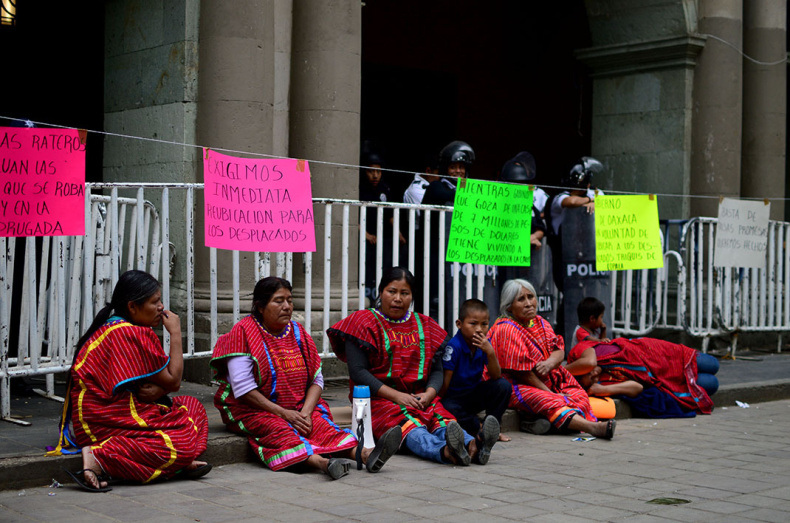
by DGR Colorado Plateau | Nov 13, 2015 | Indigenous Autonomy, Protests & Symbolic Acts
Displaced from San Juan Copala, a Triqui indigenous community in the municipality of San Juan Juxtlahuaca, the women have begun a hunger strike. They are demanding from the government the fulfillment of the promises of return to their territory or their immediate relocation.
In 2007, the struggle for the autonomy of San Juan Copala was disrupted by the intervention of the Union of Social Welfare of the Triqui Region (UBISORT), operated by the PRI, by surrounding the community and finally the expulsion of around 700 people in 2009. Lorena Merino Martinez—representative of the displaced people whose husband (along with a 7 year old boy) was assassinated in the same year by the paramilitary group—explains:
“Among those who were expelled violently it is because the government doesn’t like autonomy, there are political parties that are in with the government. For that same reason the government sent resources to the political parties in order to put an end to the autonomy, in order to be able to take possession of the community because the government finds it more convenient to have political parties and that is why they put an end to the autonomy.”
The members of the community found themselves forced to leave their territory through violence. Their dwellings, according to Lorena, are now occupied by paramilitary members, who are, in some cases, neighbors. Her husband’s murderer, who was freed in 2012, now lives in San Juan Copala. The territory, she says, contains important mineral resources. “For that reason they expelled us and now the government doesn’t see the conditions for us to return to our community.”
Under the demand for justice and the return to the community, the Oaxacan government signed in 2013 an accord for relocation, but it remained only on paper.
“September 13, 2013 we signed an agreement with the government of the State where they committed themselves to protecting the homes of the displaced and they also agreed to relocate us short term in Central Valleys in 90 days. More than two years have already passed. In Oaxaca there are private properties but the government doesn’t consider the price very high and for that reason they haven’t been relocated to this date.”

Since [Nov. 4], members of the Triqui community have been in the corridor of the government palace in the Oaxacan capital demanding the fulfillment of the agreement of 2013, but the response, one more time, was repression and removal:
“Today [Nov. 5] at 3:30 AM we got more than 200 riot police, and they removed us with force from the corridor of the palace, and dragged old women and young sleeping children, throwing us outside and sprayed gas in the faces of our children and aimed the pistols they carry. And they treat us as if we were delinquents. Three of our companions were threatened by the riot police, and a 12-year old boy was chased by the police.”
During the removal, those who objected had their belongings taken.
The situation of the displaced, it is mean, unjust and violent. Many find themselves refugees in the homes of sympathizers or live on the streets. Lorena Merino told us that they used to have coffee and banana farms and had no problems getting permission to sell their products and handicrafts. But the current conditions are difficult and painful. She is worried about the children of the community that today, because of the displacement, neither eat nor study decently.
“The truth is, living on the street is no decent place for our children, being hungry, cold and thirsty is difficult, and for that reason things have not progressed on the part of the state, and for that reason we have chosen, this day, to go on a hunger strike, right now we have been on this hunger strike for six hours, but not one government official has approached us in order to open dialogue regarding our relocation.”













